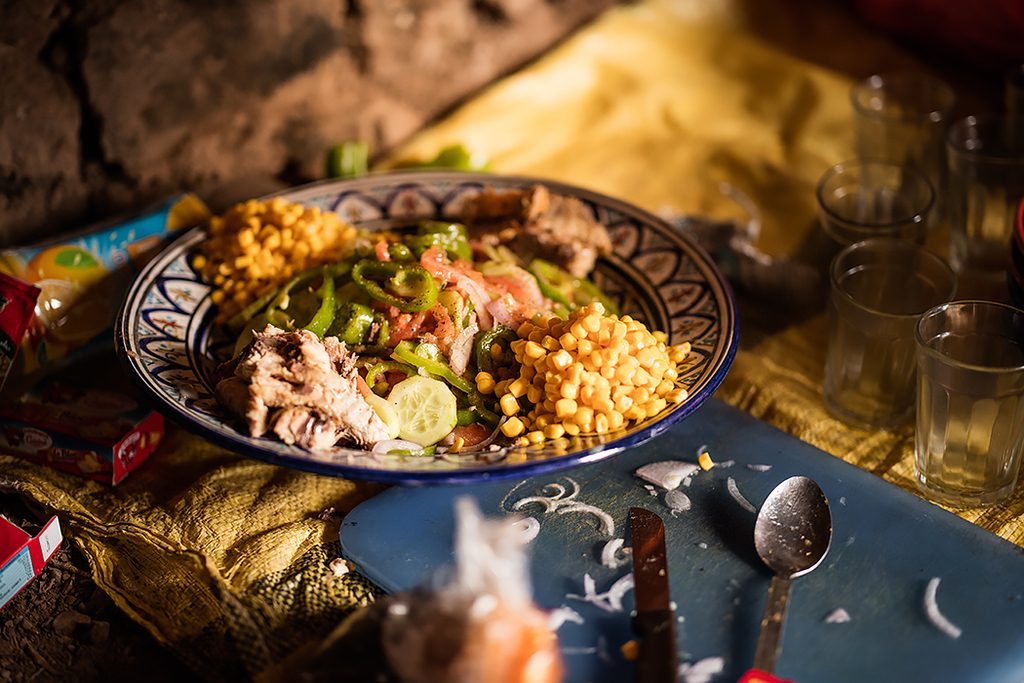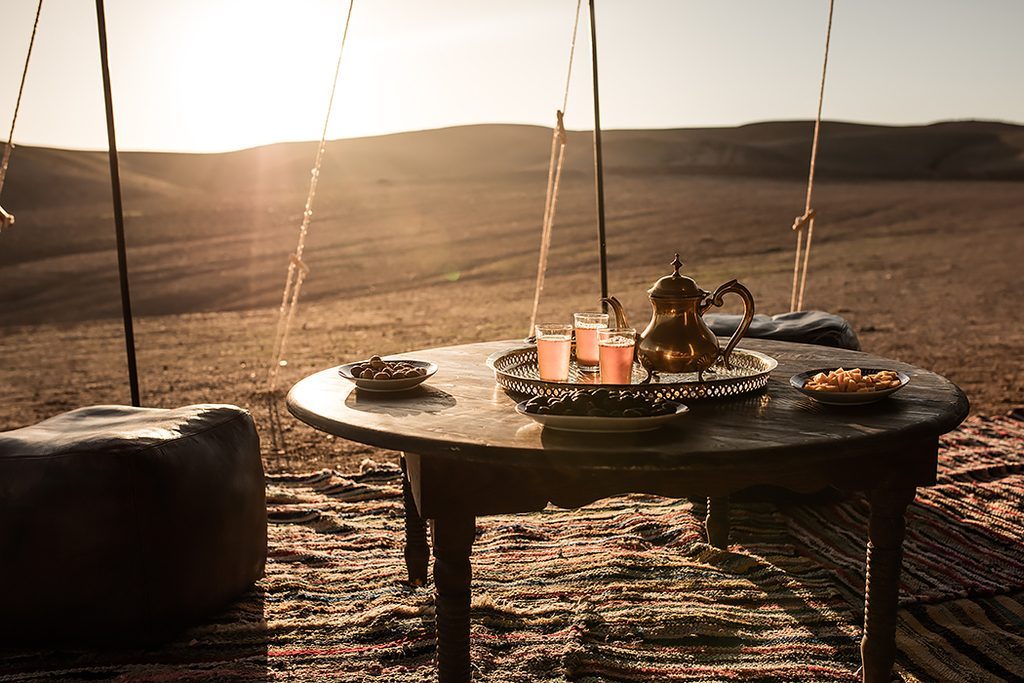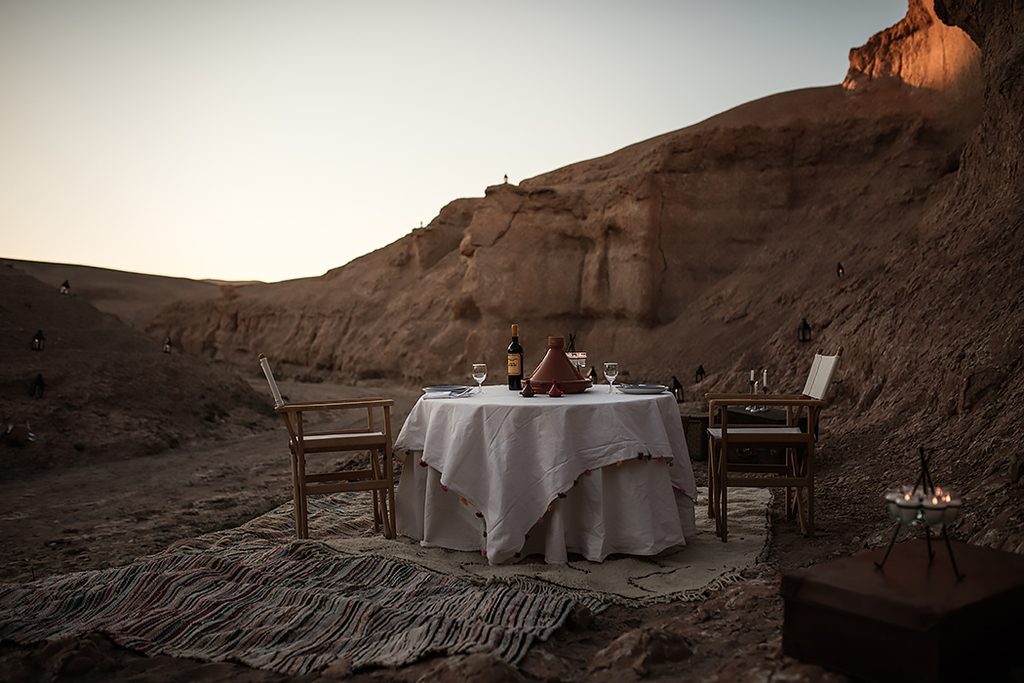Tasting Your Way Around Morocco

When people think of Morocco they usually think of Tagine and Cous Cous both of which are delicious, but Moroccan food is much more diverse, flavourful and colourful – you could easily write a book on the subject there’s far too much to cover in one blog – the spices alone deserve a chapter. Tasting the local cuisine is usually a highlight for visitors to Morocco but it isn’t really the country to come to if you want to lose a bit of weight. Sweet mint tea, almond pastries, juicy dates, freshly-baked artisan bread dipped in home-pressed olive oil… food is fresh and full of natural goodness although not necessarily low on calories.
There is a vast array of dishes to try out and to make it a bit easier we have broken it down into what you could try in some of the different regions, from the cities to the mountains and the desert. We have chosen a couple of signature dishes from each area to give you just a taster of what is available.
Before we start making your stomach rumble with a description of our favourite dishes, it is worth mentioning that Epic can organise a cooking class for you during your stay. We also specialise in doing food tasting tours in the major cities like Marrakech and Fez. Do be aware of what you are buying if you want to pick up some tasty treats whilst you’re away, ask your Epic guide for help and advice on how to choose spices, honey or oil, they know what to look for and how to judge the best quality.
What to eat in Marrakech and Fez
Couscous, is a popular dish and really tasty when cooked well by a local with that secret ingredient – love and care. It is the food of celebration, a staple on Friday’s at lunchtime after noonday prayers, it’s the equivalent of a Sunday roast in the UK. Real couscous bears little resemblance to the convenience food that the large supermarkets at home stock as it actually takes a lot of time and effort to prepare.
The base of the dish is the couscous itself which is durum wheat semolina crushed into small granules. This is then cooked in a large pot with a steamer on top where the vegetables and meat sit in order to infuse the grain below with their flavour.
The couscous is cooked three times and is carefully mixed by the women between every stage.
In Fez, you should try a Couscous Royale in honour of the Imperial City. Couscous Royale basically has all the best things in it: lamb, chicken and merguez sausages with a medley of vegetables including courgette, cabbage and gourd and then caramelized onions and sweet sultanas on top (vegetarian options are also available).
Couscous is typically served on a large dish and it’s fun (and will win you lots of brownie points) to eat it properly, which means using your right hand to gather up little balls of couscous and sauce and then pop them into your mouth. Watch out for burnt fingers. The best thing to drink with your couscous is Leben a type of thin drinking yoghurt which is full of healthy probiotics and absolutely delicious, especially on a hot day when it cools you down and quenches your thirst.
The signature dish of Marrakech is Tangia named after the deep clay pot – the tangia – it is cooked in. It’s called ‘bachelor food’ because it is so easy to make and it is the one dish the men used to make and then go off to enjoy on the Moroccan equivalent of a lads’ night out – a picnic in the gardens with some drumming.

The basic ingredients are lamb, a pinch of saffron, preserved lemon and garlic. These are put into the tangia which is sealed with parchment and then taken to the local hammam (steam baths) where it is placed in the ashes of the furnace heating the baths (the farnatchi) to slow cook.
When it’s ready, you break the seal on the pot, empty the contents out and scoop up the juices and meat with hot bread and it just falls apart it is so tender.
If its something sweet you are after – stop by a ‘Sveng’ stall, these are Moroccan donuts which are freshly cooked in front of you, served strung together through the hole in their middle and enjoyed with a coffee at many local street stalls, ask for some honey for dipping – just delicious.
There is so much you can taste and experience on the food tours we offer in both Marrakech and Fez whether you want to be more adventurous and try a sheeps head, or enjoy local delicacies such as Mechoui – slow-cooked lamb, cooked in a bar-be-que. Morocco is also famous for its many delicious vegetable and grain dishes so there is something for everyone.
What to eat in the Moroccan Atlas Mountains

The local people in the Atlas Mountains are Amazigh (Berber) and they are primarily subsistence farmers growing all their crops organically fed by spring water and tending their flocks of goats and sheep. There are also orchards of fruit trees of every kind including peach, cherry, figs, and apples which provide excellent seasonal produce. Most families will live off a small holding and will also have a cow and some chickens as well as a couple of goats or sheep which they will save for the big festival – Eid El Kabir. Bread is the staple food and meat is eaten in very small quantities as people cannot afford it every day. The average person would eat as much meat in a week as a European would eat at one or two meals.
Tagine is the basic main dish of Morocco, and refers just to the name of the pointy-lidded pot the dish is cooked in, which allows the food to be steamed and acts as a kind of hob-top oven.
Dishes in the mountains are hearty to fit with an active lifestyle choose a filling chicken or vegetable tagine as your main mountain dish, cooked over a slow charcoal fire packed with regional homegrown vegetables; potatoes, courgettes, turnip, carrots, tomato and sometimes a chilli on top, and basted in a spicey cumin, turmeric, ginger, pepper and salt sauce. The slow cooking gives tagines a rich tasty flavour which warms the cockles of your heart. The best way is to eat them is communally using your bread as a spoon to scoop up the vegetables and gravy. Three things you should know: Moroccans are obsessively clean, always, always wash your hands – at least once before eating, then when you’re sharing stay in your own lane and only eat from directly in front of you, and if you are in someone’s home don’t eat the meat until the host or hostess divides it up for everyone. Because meat is so precious, it is carefully shared out.
The other dish we’d like to highlight is the bread of the mountains which is called tannourt. This is a large, flat round bread which is crisp on the outside and softer on the inside. It is cooked by flattening the dough out into a large circle and placing it against the interior walls of a clay oven shaped like a beehive with burning wood/ashes inside. The door is then closed and the bread cooks. You can’t buy this in a bakery but on one of our hikes, an Epic guide can ask a local woman to make it for you.
What to eat in the desert in Morocco
The Sahara desert is a magical place to visit but it is a harsh and unforgiving place to live in with scarce water and crops and temperatures that soar to 50+ in the summer. In this difficult environment, people have to look after each other and it is perhaps from that necessity that the culture of hospitality which the Sahrawis (the people of the Sahara) are known for has grown.
When you arrive at a desert encampment, you will be greeted with true happiness, “Duyuf Allah,” the people say here. “Guests are from God.” No matter how little they have, they will bring out their best for you – a Saharan feast.

The first component is the tea, which is served in tiny shot glasses and is extremely strong and sweet with a froth on the top. The froth is very important and your host will spend a long time pouring and re-pouring the tea into the glasses until he gets it just right. To be polite, three glasses of tea should be offered and drunk and plenty of time taken. Sometimes, guests leave the tent after the three glasses, just to come back and drink three more.
Alongside the tea, a little feast will be spread out: dates, fresh bread, olive oil, honey, boiled butter and curdled goat’s milk. Your host will rip up pieces of bread and give them to you. It is polite to eat the whole piece that you are given as it is considered a sin to waste bread. You then use it to dip in the honey and to scoop up the butter (not together) or oil. The butter is boiled to keep it fresh in very hot temperatures where there are no fridges and tastes slightly sour. The curdled goat’s milk may sound off-putting but is a true treat and is also extremely good for you. The more you eat, the more delighted your hosts will be.
Table Manners
Table manners are different in every country so here are a few useful pointers.
- If you are in someone’s home or a camp, you will normally be given the chance to wash your hands before the meal as well as after by someone bringing round a large kettle of water which they pour over your hands into a basin.
- Always eat with your right hand.
- Before you take your first bite, it is very police to say “Bismillah” (in the name of God) – like saying Grace in Christian countries.
- Your host may well say, “Bisaha wa Raha” (health and rest) to which you can answer “L’atik a Saha” (may he give you health).
- When you are eating communally, eat what is in front of you and don’t stray into other people portions.
- Compliments are always welcome such as “beninel” which means delicious, as is a healthy appetite!
There are of course, dozens of different foods and dishes to try in this rich country, and it is definitely a place to be brave and take some culinary risks. The most important thing is to take the chance to taste lots of exciting new things.
Bisaha wa Raha!

To book a tasting tour or cooking class as part of your trip with Epic, talk to one of our travels planners at info@epic.travel